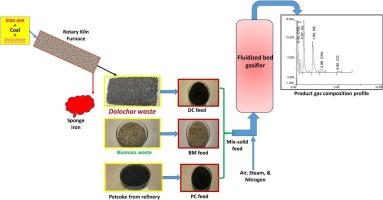Extracting the energy-potential values of dolochar via an integrated steam co-gasification route with petcoke and biomass waste
IF 7.1
2区 环境科学与生态学
Q1 ENGINEERING, ENVIRONMENTAL
引用次数: 0
Abstract
Valorization of solid waste substrates has become an essential part of society’s effort to achieve sustainability and carbon neutrality. Consequently, gasification has become a widely adopted methodology to process conventional and renewable carbonaceous feedstock into gas and liquid products in conjunction with the underutilized and prevalent waste resources. Therefore, in the current investigation, a comprehensive set of steam gasification experiments is performed for three genetically different solid waste materials, i. dolochar – an iron ore industry waste, ii. coconut waste – biomass material, and iii. petcoke – refinery waste, in a bench-scale fluidized-bed gasifier. During the detailed investigation, dolochar showed gasification reactivity and the feasibility of utilizing its carbon value to form valuable gaseous products in the form of syngas. Moreover, there was an increase in the energy value of the dolochar product gas when it was gasified with biomass and petcoke samples under identical conditions. Specifically, the carbon conversion and cold gas efficiencies significantly improved from 31.2% to 57.6% and 47.1% to 88.5% when mixed with the coconut-based biomass waste sample, with the highest H2 content achieving 32.7% in N2-mix. However, there was a major change in CO2 concentration when DC was co-gasified with PC, showing an increase in concentration from 10.4% to 18.8%; CH4 and CO contents in the mix-N2 were also highest in this case at 8.8% and 15.2%, respectively. Furthermore, various analytical methods were applied to decipher the change in the physicochemical properties.

通过与石油焦和生物质废物的综合蒸汽共气化路线提取美元的能源潜力价值
固体废物基材的增值已成为社会努力实现可持续性和碳中和的重要组成部分。因此,气化已成为一种广泛采用的方法,将常规和可再生的碳质原料与未充分利用的和普遍存在的废物资源一起加工成气体和液体产品。因此,在目前的调查中,对三种遗传上不同的固体废物进行了一套全面的蒸汽气化实验,1 . dolochar -一种铁矿石工业废物;椰子废料-生物质材料;石油焦-炼油厂废物,在一个实验规模的流化床气化炉。在详细的调查中,dolochar显示出气化反应性和利用其碳价值以合成气的形式形成有价值的气态产物的可行性。此外,在相同的条件下,生物质和石油焦样品气化的dolochar产品气的能量值有所增加。其中,与椰子基生物质废弃物混合后,碳转化率和冷气效率分别从31.2%提高到57.6%和47.1%提高到88.5%,其中H2含量最高,在n2混合物中达到32.7%。然而,当DC与PC共气化时,CO2浓度发生了较大变化,浓度从10.4%增加到18.8%;混合n2中CH4和CO含量最高,分别为8.8%和15.2%。此外,还应用了各种分析方法来解释其物理化学性质的变化。
本文章由计算机程序翻译,如有差异,请以英文原文为准。
求助全文
约1分钟内获得全文
求助全文
来源期刊

Waste management
环境科学-工程:环境
CiteScore
15.60
自引率
6.20%
发文量
492
审稿时长
39 days
期刊介绍:
Waste Management is devoted to the presentation and discussion of information on solid wastes,it covers the entire lifecycle of solid. wastes.
Scope:
Addresses solid wastes in both industrialized and economically developing countries
Covers various types of solid wastes, including:
Municipal (e.g., residential, institutional, commercial, light industrial)
Agricultural
Special (e.g., C and D, healthcare, household hazardous wastes, sewage sludge)
 求助内容:
求助内容: 应助结果提醒方式:
应助结果提醒方式:


